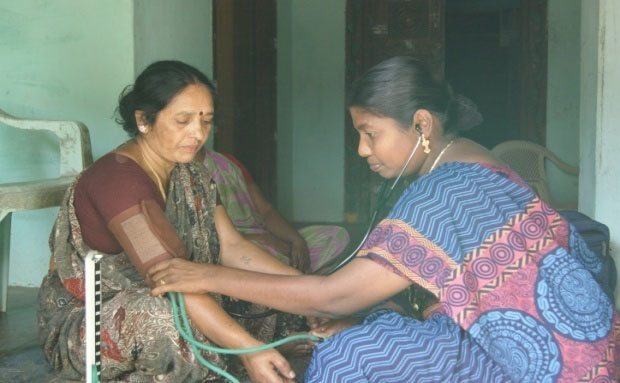By Sangeetha Lakshmanan, Research Analyst – ICTPH
It’s a hot sunny morning in Thanjavur and the ICTPH Guide is packing her bag and getting ready to pedal her cycle to make home visits. One may wonder: where is she going and what will she be doing? The answer is that the Guide will be travelling far and wide within her locality, to visit every home and make annual health examinations (through screening) a reality for rural populations.
The PISP originated with a core understanding that there is a huge unmet need in terms of delivering quality health care, which has been profoundly impacted by discrepancies in the assessment of burden of disease in rural India. Further, the lack of non-invasive tools for screening disease and a dearth in human resources have led to skewing of diagnosed disease towards urban populations. In order to account for this, the Guide will use simple cost effective, validated tools as part of her Guide Kit to identify at-risk and diseased groups within her village.

As of March 1, through the multiphasic PISP, the 12 Guides have collectively screened close to 3000 individuals to assess the true burden of a number of conditions such as hypertension, diabetes, and obesity, (by measuring height, weight, waist circumference and blood pressure), presence of acute and chronic conditions, risk factors of smoking patterns, nicotine dependence, hazardous drinking (with the help of the Fagerstrom and Fast Alcohol Screening Test – FAST) and visual acuity using the Snellens chart – all assessments which have a profound impact on individuals across a wide spectrum from infants to adults.
The next logical step of this proactive exercise is to quickly interpret this information and report back to individuals at risk, informing them of their current health status and refer them to a healthcare provider of their choice for further diagnostic work up/treatment to reverse the prognosis of the health condition. Interpretation is not only useful for health systems perspective, but is critical for the individuals themselves to actively seek care towards early wellness management.
The Health Management Information System (HMIS) at ICTPH has successfully integrated the health data, allowing space for analysis based on careful individual risk profiling. Recently, the HMIS has generated the first set of automated reports for 24 households in the local language of Tamil. The HMIS not only includes graphical representation of the high risk individuals but also highlights individuals with multiple risks. The data syncing and automatic analysis at the Rural Micro Health Centre (RMHC) level helps the nurse to understand specific health needs of families and make focused follow-up plans, establishing continuum of care from the RMHC to the community through the Guide.
The report delivery follows the same channel as the collection of data in that it further establishes the relationship between the Guide and families. The Guide carries with her the household report in a sealed paper bag and sits down with the head of the family explaining the contents of the report. Those who are at risk are referred to a healthcare provider of their choice.
You may be wondering: what do the Guides themselves think about the “reporting back” exercise? “Many people have come to our house, collected information about our family and never returned”. Additionally, the Guides also gave feedback on how they would always get results of any tests or consultation in English, making it hard to read, let alone interpretation and understanding. The Guides felt that the report could be useful as a reference point with any doctor or during health emergencies, thus further emphasizing the need to have access to this report in Tamil and not only in English. The Guides found value in reporting back to homes, highlighting the trust they would earn for returning all the way back with customized reports at the doorstep of community members, revisiting that screening may be the next logical extension to deliver quality and comprehensive primary healthcare for rural populations (Park, 2007).
For a sample Individual Health Report, see here: English, Tamil .
Bibliography
Park. (2007). Screening for Disease. In K. Park, Parks Textbook for Preventive and Social Medicine (pp. 115 – 122). M/s Banarsidas Bhanot.


Leave a Reply
5 Comments on "Population-based Individual Screening Protocol (PISP): Reporting Back to Rural Communities for Increased Health Seeking Behaviour"
Agree, health diagnosis is an important starting point for a journey of good health and well-being. The key question now, as you rightly pointed out, is – what next? If the availability and/or affordability of health services is beyond the reach of poor households, I am not sure which is better – living with an undiagnosed disease or a diagnosed one? It is like a person who is given a report card that she is illiterate but is unable to find anyone who can shed some light on her dark life.
I can’t imagine that I will be like that in the Photo doing a community service this coming weekend. Right now, I have to purchase my of stethoscope and a new sphygmamometer. the last one was broken when it was squeezed. My friend recommended me to a site, this one http://www.pulsestore.com/medical-instruments.aspx and she say that they have good quality sphyg. What do you think is a good one?